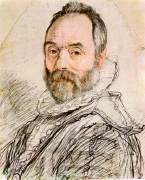 |
GIOVANNI DA BOLOGNA(Giambologna, originally Jean Boulogne) Biography |
In about 1550 he went to Italy to study and spent 2 years in Rome. On the way back he
stopped in Florence and was based there for the rest of his life. The work that made his
name, however, was for Bologna - the Fountain of Neptune (1563-66), with its impressive
nude figure of Neptune which he had designed for a similar fountain in Florence (Ammanati
defeated him in the competition). Even before working on the fountain in Bologna, however,
Giambologna had begun in Florence the first of a series of celebrated marble groups that
in their mastery of complex twisting poses mark one of the high-points of Mannerist art:
Samson Slaying a Philistine (Victoria and Albert Museum, London, c. 1561-62); Florence
Triumphant over Pisa (Bargello, Florence, completed 1575); The Rape of a Sabine (Loggia
dei Lanzi, Florence. 1581-82); Hercules and the Centaur (Loggia dei Lanzi, Florence,
1594-1600). Giambologna worked extensively for the Medici and his monument to Duke Cosimo
I (1587-95) was the first equestrian statue made in Florence and an immensely influential
design, becoming the pattern for similar statues all over Europe (for example that of
Charles I by Hubert Le Sueur at Charing Cross in London). Giambologna's similar statue to
Henry IV of France, formerly on the Pont Neuf in Paris, has been destroyed.
It was for the Medici that he made his largest work — the colossal (about 10 m. high)
figure of the mountain god Appennino (1577-81) in the gardens of the family's villa at
Pratolino. Constructed of brick and stone, the god crouches above a pool and seems to have
emerged from the earth, fusing brilliantly with the landscape. Giambologna was as happy
working on a small scale as in a monumental vein.
His small bronze statuettes were enormously popular (they continued to be reproduced
almost continuously until the 20th century) and being portable helped to give his style
European currency. A series of bronze statues of Mercury culminated in the renowned
“flying” Mercury (1580, Bargello, Florence), outstanding for the airy elegance
of its pose: the nude figure stands poised on the toes of the left foot, with the right
arm raised high in a pointing gesture. Many of his preliminary models also survive
(uniquely for an Italian sculptor of his period), giving insight into his creative
processes. The best collection is in the Victoria and Albert Museum.